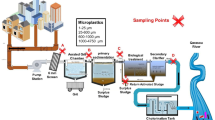Abstract
A few sections of the sewers in Watertown were experiencing clogging due to an excess biomass growth. It was suspected that the wastewaters discharged from Fisher-Barton's two facilities were causing excess biomass growth. Madison raw sewage had a slightly lower biomass growth than the mixture of industrial wastewater and domestic sewage samples. From microscopic examination of biomass, the main cause of excess biomass growth is thought to be toilet tissue. Biomass is attached to toilet tissue, decomposing it gradually and generating extracellular polymeric substances (EPS). Then, suspended particulates including graphite and precipitates are attached to the biomass and filamentous organisms, especiallySphaerotilus natans, leading to the increase in the biomass volume. We found that the filamentous bacteria were present in biofilm by FISH. A significant amount of graphite was embedded to biomass grown in sewer. Since the major cause of excess biomass appeared to be toilet tissue, it would not be economical to employ a filtration system for complete graphite separation. Instead, it is recommended that the manufacturing process where graphite is used be assessed and a best management practice is in place. Key words: Excess Biomass Growth, FISH, Sewer, Evaluation, Wastewater
Similar content being viewed by others
References
Amann, R. L, Ludwig, W. and Schleifer, K. H., “Phylogenetic Identifi-cation andin situ Detection of Individual Microbial Cells Without Cultivation”,Microbiol. Rev.,59, 143 (1995).
Borsodi, A. K., Farkas, I. and Kurdi, P., “Numerical Analysis of Plank-tonic and Reed Biofilm Bacterial Communities of Lake Fertö (Neus-iedlersee, Hungary/Austria)”,Wat. Res. 32, 1831 (1998).
Burchard, R P. and Sorongon, M. L., “A Gliding Bacterium Strain Inhib-its Adhesion and Motility of Another Gliding Bacterium Strain in a Marine Biofilm”,Appl. Environ. Microbiol.,64, 4079 (1998).
Cao, Y S. and Alaerts, G. J., “Aerobic Biodegradation and Microbial Population of a Synthetic Wastewater in a Channel with Suspended and Attached Biomass”,Wat. Sci. Tech.,37, 181 (1995).
Eikelboom, D. H., “Filamentous Organisms Observed in Activated Sludge”,Wat. Res.,9, 365 (1973).
Flemming, H. C., Wingender, J., Moritz, R., Borchard, W. and Mayer, C., “Physico-Chemical Properties of Biofilms”, A short review, In”, Biofilms in the aquatic environment (eds.; Keevil, C. W., Godfree, A., Holt, D., Dow, C.) Cambridge, The Royal Society of Chemistry (RSC), 1 (1999).
Jahn, A. and Nielsen, P. K., “Cell Biomass and Exopolymer Composi-tion in Sewer Biofilms”,Wat. Sci. Tech.,37, 17 (1998).
Manz, W., Wagner, M., Amann, R. and Schleifer, K. H., “InSitu Char-acterization of the Microbial Consortia Active in Two Wastewater Treatment Plants”,Wat. Res.,28, 1715 (1994).
Manz, W., Wendt-Potthoff, K., Neu, T. R., Szewzyk, U. and Lawrence, J. R., “Phylogenetic Composition, Spatial Structure, and Dynamics of Lotic Bacterial Biofilms Investigated by Fluorescentin situ Hy-bridization and Confocal Laser Scanning Microscopy”,Micro. Ecol.,37, 225 (1999).
MacDonald, J. A., “Microscopic Evaluation of a Collection System Sam-ple Received from Watertown”, Wisconsin, Final report, MacDonald Environmental Services, Project No. 00-31 (2000).
McFeters, G. A., Stewart, P. S., Huang, C. T., Wentland, E. J., Xu, K. D. and Yu, F P., “Physiological Heterogeneity and Biofilm Control”, In; Biofilms in the aquatic environment (eds.; Keevil, C. W., God-free, A., Holt, D., Dow, C.) Cambridge, The Royal Society of Chem-istry (RSC), 51 (1999).
Metcalf, Eddy, “Wastewater Engineering: Collection and Pumping of Wastewatef”,3 rd ed., McGraw-Hill, New York, NY (1991).
Nielsen, P. H., Andreasen, K., Wagner, M., Blackall, L. L., Lemmer, H. and Seviour, R. J., “Variability of Type 021N in Activated Sludge as Determined byin situ Substrate Uptake Pattern andin situ Hybrid-ization with Fluorescent rRNA Targeted Probes”,Wat. Sci. Tech.,37, 423 (1998).
Reasoner, D. and Geldreich, E. E., “A New Medium for the Enumera-tion and Subculture of Bacteria from Potable Water”,Appl. Environ. Microbiol.,49, 1 (1985).
Stackebrandt, E., Murray, R G. E. and Truper, H. G., “Proteobacteria Classis Nov., a Name for the Phylogenetic Taxon that Includes the Purple Bacteria and Their Relatives”,Int. J. System. Bact.,38, 321 (1988).
Wagner, M., Amann, R, KÄmper, P, Assmus, B., Hartmann, A, Hut-zler, P., Springer, N. and Schleifer, K. H., “Identification andin situ Detection of Gram-negative Filamentous Bacteria in Activated Sludge”,Appl. Microbiol.,17, 405 (1994).
Woese, R. P., “Bacterial Evolution”,Microbiol. Rev.,51, 221 (1987).
Yoo, C. K., Kim, D. S., Cho, J. H., Choi, S. W. and Lee, I. B., “Process System Engineering in Wastewater Treatment Process”,Korean J. Chem. Eng.,18(4), 408 (2001).
Author information
Authors and Affiliations
Rights and permissions
About this article
Cite this article
Park, JH., Lee, YO. & Park, JK. The evaluation of excess biomass growth in sewers. Korean J. Chem. Eng. 20, 878–885 (2003). https://doi.org/10.1007/BF02697292
Received:
Accepted:
Issue Date:
DOI: https://doi.org/10.1007/BF02697292




